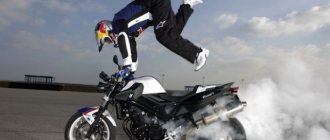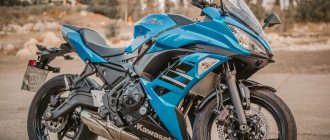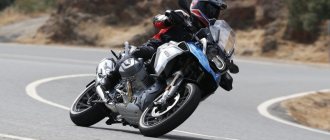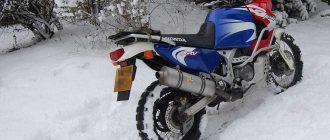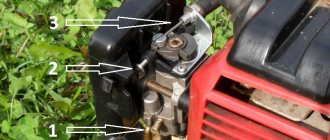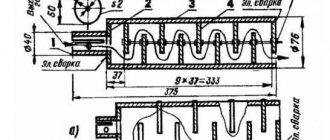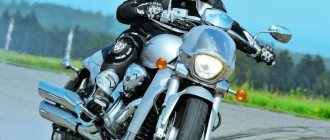Wheelie or wheelie is the most famous trick that is performed on a motorcycle even by ordinary riders. Almost every second motorcyclist thought about how to ride on the back, get adrenaline, show off or take a beautiful photo.
Is it necessary to turn on the boring mode to remind you that wheelie training should not take place on a public road, where the slightest mistake can result in a spectacular fall and random victims hit by the inertia of a motorcycle. Naturally, the motorcyclist must be fully equipped so that in the event of a fall he will not pay for the mistake with his health.
“We choose equipment for the stunt. Experience of stunt riders"
Wheelie seems like a simple trick when done by professionals or fairly experienced motorcyclists. However, there are many nuances in execution, and mistakes during training are costly. Literally everything matters here: the preparation of the driver, the moment for lifting the wheel, the position of the body from the beginning to the end of the wheelie, the reaction at the moment the wheel is lowered, the motorcycle itself and its technical condition... In this article we are not talking about professional stuntriders, but looks at their experience and achievements.
Warning
Any professional “stuntman” will tell you that for constant somersaults, the motorcycle will need the help of a mechanic. The fact is that when riding for a long time on the rear wheel, the bike begins to simply starve of oil. This is understandable, the laws of physics have not been canceled! A motorcycle raised vertically causes technical fluids to drain, which are no longer distributed evenly throughout the crankcase and parts, but tend downwards under their own weight. This also applies to the gasoline in the gas tank.
Many people listen carefully to how a motorcycle works in a wheelie in order to determine the moment when it is time to stop and stop forcing the machine, which is not suitable for stunts.
“A motorcycle for stunt riding - what is it? First part"
“Stuntriding is gaining momentum - why?”
The second problem may be the design of the motorcycle itself. It is much easier to stand on the rear wheel on short bikes than on long bikes. It’s not for nothing that an extended pendulum is specially installed on some models, including this is a common practice for powerful motorcycles on which they openly drift and in every possible way prevent the appearance of wheelies due to the design.
Among the problems created by the motorcycle itself are the long exhaust pipes. If you stand on your rear wheel and align yourself almost to the “candle”, do not forget to watch whether you are touching the asphalt with pipes or a license plate. Sparks, of course, add beauty, but this is another reason to lose balance and then “heal” the scratches of the war horse.
In general, if you want to lift your bike onto the rear wheel just for beauty, in the mood to tickle the nerves of yourself and oncoming car drivers, you need to understand how your motorcycle model generally tolerates such tricks, and what line to step over is fraught with.
Even the condition of the rear tire and its pressure affects the quality of the wheelie. Professionals generally reduce the pressure to increase the contact patch and add stability.
Acrobatics.
In principle, almost any trick, except for the basic Willie, Stoppy and Burnout, in Stunt Riding involves elements of acrobatics. But there are also simply purely acrobatic elements performed without annealing the rubber and on both wheels.
Probably the most famous of these tricks is the Cross, although I prefer the name Jesus Christ. In the village, this is one of the tricks that is performed together with Willie and Burnout, due to its relative availability in a basic version for brave future stunters. You just need to accelerate the motorcycle, and then stand on the saddle or gas tank at full height, taking your hands off the steering wheel. In the canonical execution, also moving them apart.
The rest of the tricks presented in this section already require a lot of preparation and training, and some of them are generally only possible for stunt riding professionals. Well, physical fitness should already be at a very high level.
4.1. Headstand, Handstand, Switchback coffin zero.
Various options for motorcycle racks. When performing a Headstand trick, the rider stands on his head, while in a Handstand, he stands on his hands. It’s not for nothing that Switchback Cofin has the word “coffin” in its name, since it is performed while driving backwards, holding the tail of the motorcycle with your hands and steering with one foot.
4.2. Acid drop, Elevator and Deactivator.
Various options for jumping and jumping onto a motorcycle when performing stunts. An acid drop looks like a quick jump after performing some other trick, such as a Cross, onto a tank, saddle or crossbar, and often turns into another trick.
An elevator is a cross jump or other trick that involves standing on a motorcycle at full height.
Deactivator - the rider simply jumps off the motorcycle, the motorcycle moves on without him, while he, for example, attracts a crowd of spectators, then the rider catches up with him and continues the performance.
In essence, this category cannot be called independent tricks; they are simply beautiful and technical transitions from one trick to another.
Bonus
What is the most dangerous thing about doing a wheelie: going up on the back wheel or going back down? One way or another, returning the wheel to the asphalt is not the last thing. With a sharp impact, you can catch a wobble or not hold the steering wheel at all, and still make a not very stellar, but head over heels landing. At such moments, a damper comes to the rescue of beginners. Experienced motorcyclists who practice wheelie riding have a trained eye. They are able to lower the bike carefully. A relaxed seating position helps them with this (to prevent vibrations from passing from the wheel through the driver to the entire motorcycle) and correct body position.
Beginners make one big mistake - they accidentally press the gas instead of the brake while lowering the wheel.
"Hand work while riding a motorcycle"
"Wobbling on a motorcycle in Russian"
Speed
It is difficult to pinpoint the exact speed at which it is best to learn to do a wheelie. In principle, this is not so important for mastering, the main thing is not to set a very large or very small gear. The gearing should be approximately the same as what you usually use on sidewalks - well, or a little lighter. Usually this is in the range from 1-5 to 2-4 (however, again, other articles advised even more than 2-4 - try all options). You need to learn to pull from about 10-12 km/h - doing a wheelie from a standstill (or at low speed) will be much more difficult.
Education
For training, many people use lightweight cross-country motorcycles, which are not as scary to roll over sand as it is to scrape a sportbike on the asphalt. There are many options for training equipment, the main thing is that there is a minimum of plastic, a short wheelbase and survivability in falls.
Practice should take place in areas isolated from active traffic. Ideally, turn to more experienced motorcyclists, instructors, or take a few lessons at schools that can teach such elements.
The safest way to develop wheelie riding skills is to practice on a wheelie machine... by the way, Partner-Moto has it. The essence of a wheelie machine is that the driver ceases to be afraid of falling, since he is limited and held by the equipment. Fatal mistakes will not end in disaster.
The difficulty of a wheelie is not only in raising and lowering the front wheel, but also in keeping the motorcycle level without tilting to the side, which can cause you to simply fall over, not to mention tip over backwards.
It is recommended to make the first attempts to perform a wheelie in first gear. The point is not to accelerate to escape speed, but to increase the speed, and the motorcycle rides steadily at idle with the throttle closed. Beginners are advised to lift the front wheel with the clutch, as this allows you to work at low speeds without sudden jerks. We will talk about the intricacies of working with gas, clutch and brake in a separate article. Now let us note that in training it is not recommended to change gears.
To try lifting a motorcycle into a wheelie and not be afraid of crashing your bike, you can contact Partner-Moto to gain the skills of wheelie riding using a wheelie machine and a specially prepared motorcycle.
Burnaut.
Burnout is, in our opinion, annealing. And it’s true what they say: whoever hasn’t burned, hasn’t ridden a motorcycle! This trick in its basic version is quite simple, so it is often performed by ordinary amateurs.
A basic burnout is very simple to perform and often does not even require loading the motorcycle fork. You need to unload the rear, gain a sufficient number of revolutions, then release the clutch. More complex versions of burnout - in motion and turns (Rolling Burnout) - are already elements of stunt riding, they look impressive, although they finish off the rubber in a matter of minutes.
3.1. Suicide bernout, Chainsaw, Hyperspin, Crazy Larry.
What these tricks have in common is that the rider is on the ground when performing them. Suicide is performed while standing in front of the front wheel of an annealing motorcycle.
Chainsaw - When the bike spins around the rider in Burnout.
Carousel - when the motorcycle lies on the guard and rotates around the slider, for example, with the rider on it. Crazy Larry - Burnout around the leg.
3.2. Track stand, Drift, Switchback drift.
Burnouts, which are performed without your feet touching the asphalt. When performing the Track stand, the rider performs Burnout while standing on the pegs; Drift - he also drifts in Africa. Performing the Switchback Drift stunt involves drifting while sitting on a motorcycle backwards.
Common Mistakes
List:
- Arms bent at the elbows. Keep your arms straight.
- Stop trying after the first failures. Remember your persistence when learning to ride your first bike. Don't stop halfway.
- When the steering wheel jerks, immediately move on to further elements of the trick. The jerk itself is not able to keep you in the air. Pedal and move forward.
- Many people instinctively tend to lean closer to the steering wheel. This situation seems safer to them. However, it is almost impossible to maintain balance in it. It is important to overcome your fears and act consciously.
- Sudden jerky movements and too much speed will almost certainly cause you to fall. Practice moderation.
Preparation
Let me make a reservation right away - we do absolutely everything without lifting our butt off the saddle. The pushing leg is the one that is in the back during normal driving (during a jump, during all tricks) (it is more convenient to jump on one leg and you will put it out so as not to fall if you are unexpectedly pushed in the back). Keep your finger on the rear brake, the brake must be well tuned and adjusted - of course, hydraulics are desirable, but on vibration breaks you can also easily spin wheelies. Let's go. We bend our elbows and lean slightly towards the steering wheel. We go like this until the connecting rods are parallel to the ground (or at an angle - so that the front leg is lower than the back one), and the pushing leg is behind. If it is not clear, I will explain it differently - the initial pressure on the pedal is made by the pushing leg - for this it must be in a “charged” state, i.e. behind or above. At this moment a jerk is made.
Returning the motorcycle with the brake
When you learn to pull the motorcycle to the balance point in a stable and controlled manner and drive a few meters, you should try to lift the motorcycle beyond the balance point and return it with the rear brake. Strictly speaking, this is a wheelie. Those. The goal is to raise the motorcycle above the balance point, bring it back with the brake, add gas if it starts to fall, and so on ad infinitum. To quickly get used to the brake and apply the brakes correctly, apply the brakes before the wheelie starts (your foot should slightly press the rear brake).
Customizing the Motorcycle and Controls
But before you start learning to ride an enduro motorcycle, you need to at least slightly adjust the motorcycle to suit you.
Steering spacers
Many beginners rush to install steering wheel spacers to make it taller. But I assure you, if you are not Uncle Styopa, height 1.90 or more, then spacers are not needed!
Brake and clutch levers
The brake and clutch levers should be installed slightly below the horizon, along the line of the forearm. Also, these levers should be shifted as far as possible to the center of the steering wheel, firstly, to reduce the pressing force, due to the increased leverage, and secondly, this way there is less chance of breaking them. And if you don’t use handle protection, then you should wrap fum tape under the levers so that when you fall, the levers rotate on the steering wheel and don’t break off.
Brake pedals and gearbox
The gearshift pedal is installed slightly higher than the footrest, primarily for ease of shifting in the stance. The rear brake pedal is set level or slightly above the footrest.
Setting the rear suspension spring preload
You also need to at least slightly adjust the suspension to the rider's weight. If you are a beginner, you are unlikely to change springs to suit your weight. But at least it’s worth adjusting the shock absorber spring preload. It's not difficult to do this. Measure the distance, for example, from the rear wheel axle to the fender on an empty motorcycle. Then, stand on the footrests and ask a friend to measure there. The difference between the empty motorcycle and the weight of the rider in the equipment should be within 8-10 cm. This is how the motorcycle suspension will work best.
Equipment
Safety in enduro, of course, starts with equipment. In addition to a helmet, an endurist desperately needs tough motocross or enduro motorcycle boots. There are two types of endurists. The first ones buy motorcycle boots before the injury, the second ones after the injury. Oh, it doesn't roll. You can fall even at about zero speed, and most likely the motorcycle will fall on your leg. In this case, the likelihood of injury is extremely high and it does not matter whether you are wearing ankle boots or sneakers. Turtle, knee pads and “armored underpants” will also not hurt at all.
Jerk
From this position, we sharply turn the pedals and, straightening our arms, pull the pedal back.
Attention : the main effort is made on the pedal, with the body we simply move the center of gravity back. If you jerk your hands too much, the bike will wobble a lot and it will be more difficult to maintain balance. During training, pay attention to the strength of the jerk - beginners make two main mistakes: “over-pulling” - the bike is pulled too hard, the biker gets scared and sharply presses the brake (this can be repeated many times) - and “under-pulling” - the bike is not pulled out enough to get there to the balance point, the biker rides on the back, but not for long - due to acceleration (more on this below). Both are undesirable. Try to find an intermediate state - this is the whole essence of wheelie.
The need to register your motorcycle
For real bike lovers, this type of equipment is not perceived as a means of transportation. For them, this is a reflection of the state of their soul. And every motorcyclist strives for freedom. But, before you start conquering limitless space, you need to register your motorcycle. You need to register it. What is needed for this?
- Preparation of documents. You will need to have with you an identification card, compulsory motor vehicle insurance, a document that confirms your rights to your motorcycle.
- The registration procedure itself with the traffic police, which can take several hours.
Registration of a motorcycle and its registration is a mandatory procedure. You can go through all this on your own. But if you don’t have enough time for this, you can contact specialists who will carry out this entire procedure in a very short time. But this service is paid.
Having registered a motorcycle and received its number, you must inform the insurance company so that the number can be included in the insurance policy. By turning to professional experts for help, you can allow yourself to think about the adventures that await you ahead while your documents and number are being prepared.
Frontflip
Frontflip or “front flip” is one of the most difficult elements of modern freestyle motocross.
360 degrees
360 degrees is a trick that requires you to rotate your motorcycle 360 degrees in the air.
Body Variation
Motorcycle alarms Body Varial is a trick in which the athlete turns 360 degrees above the motorcycle, and the motorcycle flies along a normal trajectory.
Shoes on the ground
It's also a bad idea to keep your feet on the ground.
Shuffling feet occur because the steering wheel is held too tightly. It makes you lose your balance, says the motorcycle instructor. If you can't help but want to swing your legs to the side, look up, squeeze your knees and relax your arms. Sure, you can regain your balance with your foot, but doing so can cause you to twist your ankle. When you have both feet on the ground, you cannot hold the motorcycle. When you sit on the couch, you add weight to the bike and have more control when it's stationary.
Obtaining a license to drive a motorcycle or ATV
Until control of your motorcycle reaches the level of reflexes, it is not advisable to go outside.
If you only need a motorcycle to ride around the surrounding area on weekends, you can learn to drive it yourself with the help of more experienced friends. But if your intentions are more serious, then your training should take place under the guidance of an experienced trainer.
To drive a motorcycle you need driver category A.
If you are already sixteen, if you do not have any medical contraindications, you can safely take training to drive a motorcycle. To do this, you undergo theoretical and practical classes. At the motorcycle school, they will help you study the structure of your bike, understand the rules of the road, and teach you the rules of first aid.
Practical classes will be held in open areas to acquire the necessary skills in controlling your motorcycle. Modern city streets are so busy that management will require proper skill from you. It is training under the guidance of a knowledgeable person that will help you feel more confident and calm on the road or highway.
How to get a motorcycle license? This is done after completing the training.
The first step is to collect the necessary documents.
- Use letterhead to fill out an application to your local traffic police department.
- When you graduate from a motorcycle school, you must attach a certificate of training; otherwise, you fill out a driver’s exam card.
- A medical certificate containing notes from all doctors.
- Prepare two photographs in advance.
- A document that confirms your identity and registration.
- You will need to pay the exam fee and present a receipt.
You will first have to pass a theoretical exam. If you pass the exam successfully, you will take the practical part of the exam within three months. Having successfully passed all the tests, you receive a license to drive a motorcycle.
If your hobby is not a motorcycle, but an ATV, then to your question of how to get a license for an ATV, we will answer you this way: you need to go through almost the same thing as when getting a license for a motorcycle. But ATVs are equal to tractors. Therefore, you will be given category A1, and you will receive the title “tractor driver”.
You will need a license for an ATV even if you are only going to ride it in the forest. To participate in competitions, rights will be required.
Sports riding technique. Read before your spring trip.
Contents of the material
- Sports riding technique. Read before your spring trip.
- Chapter 1. Weak Link.
- Chapter 2. Basics of braking and steering.
- Chapter 3. Keep your eyes open.
- Chapter 4. Steer confidently.
- Chapter 5. Under gas.
- Chapter 6. Brakes
- Chapter 7. All about external factors.
- Chapter 8. Time to go to the track.
- Chapter 9. Survive in the city.
- Chapter 10. Traveling in a group.
- All pages
Page 1 of 11
How to develop skills that improve speed, safety and confidence on the streets and tracks.
Acknowledgments
When I finished my first book, the relief was so great that I wanted to thank everyone on the planet. But even if I wanted to thank only those who helped me during my 29-year biography, then the list would be very long and very significant for me. However, I was asked, if possible, to limit myself to people who helped in the work on the book.
David Bull Publishing. Thanks to designers Tom Morgan and Anna Gilbert for their excellent work, and to editor Rachel Bernstein for her wonderful editing. I would like to express my deepest gratitude to my friend and fellow rider, publisher David Bull.
Photographers. As we journalists say: no pictures, no article. Without the competent work of these people there would be no book. Special thanks to photography aces Brian Jay Nelson, Brian Blades and Dennis Morrison. Thanks also to Jeff Allen, Dexter Ford, Patrick Gosling, Fran Kuhn, Gary Lehman, Jay McNally, George McQuiston, Tom Ryles, Dennis Scully, and Mark Urbano. Great job, gentlemen.
Illustrator. Special thanks to Hector Cadematori, a motorcycle illustrator who can understand the most complex idea and then depict it clearly and convincingly.
Publisher of Cycle World and Sportbike magazines. These guys took pictures, posed for photos, and helped in a hundred other ways. Thanks to super riders Don Kanet and Mike Sernicki. Thanks also to David Edwards, Brian Catterson, Matthew Miles, Mark Heuer, Jimmy Lewis, Robin Davis, Brad Zerbel, Elani Anderson, Paul Dan, Jason Colon, Ben Welsh, Jason Black, Jim Yeardley, Todd Egan, and John Casimer. Great people, great articles. And, David, I couldn't have done it without you.
Publisher of Motorcyclist and Sport Rider magazines. I started writing the book while I was working at Sport Rider, and I want to thank the team who put the idea into my head: Art Friedman, Mitch Boehm, Lance Holst, Jason Black, Sebhan Burns, and Angela Barosso.
My racing partners. Racing taught me a lot, all because with such great support I could focus solely on driving. I would like to thank everyone who helped me at the races, but I will limit it to the team with which I won club and national championships: Steve Biganski, Craig Arion, Kevin Arion, Steve Johnson, John Cordona, Dan Kiley, Glenn Cook, Dennis Smith, Jim Allen , Bob Graham, John Winslett, Tommy Lynch and Larry Pegram.
I would also like to thank those who taught me to ride and race: Keith Code, Eddie Lawson, Wayne Rainey, Thomas Stevens, my dirt track coach Jeff Haney and most importantly, the boss of my motorcycle school, Freddie Spencer. I have learned and continue to learn a lot from Kenny Roberts' book, and I thank King Kenny for his foreword.
I also have to thank my wonderful parents, Ellie and Bill Jenatsch, my wonderful wife Judy, who inspired me, rode with me and made my life so much easier, and the Lord our God Jesus Christ. Finally, I thank all the readers of this book.
Nick Jenach, January 2003
PREFACE
The path to the right skills is training, training, training...
The guy who wrote this book has seen first-hand how hard the best racers work to get to the top and stay there. Nick learned dirt track on my California ranch with guys like Wayne Rainey, Eddie Lawson, John Kosinski and my sons Kenny Junior and Curtis. Driving on asphalt is just a game compared to training on a dirt track.
I first met Nick in 1990 when he came to the Ranch with Eddie Lawson. At that time, he was just starting to race in the 250 class. A journalist is always a hemorrhoid, so we drove him hard in motocross and dirt track. But he didn't complain. The younger one was then starting to race the 250 in the WERA championship, so I kept an eye on the sports news. From them I learned that Nick finished in the top three in the AMA championship several times. He also performed well on four-stroke Hondas. Not bad for a journalist.
This book is not about racing, but mainly about driving on public roads. Where the goal is not limited to just improving lap times. Most people cannot even drive a car properly, let alone a motorcycle. I hope that “Sport Riding Techniques” will help someone. I believe in training and technology, and this applies to any level - from Moto Grand Prix to simple weekend rides. I know Nick has been writing articles for motorcycle magazines about racing techniques for many years, so I feel confident in recommending this book. I like anything that improves my driving skills.
Nick mentioned that my book, Motorcycle Riding Techniques, helped him. I hope his book helps you. He worked hard on himself, and this book is the culmination of his efforts.
Kenny Roberts.
THE BIRTH OF A BOOK
Welcome to Sports Riding Techniques, a book dedicated to efficient motorcycle riding on the streets and race tracks. I mentioned the tracks because only there you can learn the absolute limits of the bike and its rider. Some things in this book are best used only in racing. However, the book is mainly concerned with driving on ordinary roads, because they require special skills and pose their own demands. Anyone who has ever driven along a winding road has become forever addicted to this exhilarating, delightful and (if careless) potentially dangerous activity.
This book is based on numerous articles I have written about the human side of the rider-motorcycle system for Motorcyclist, Sport Rider, Sportbike, and Cycle World magazines. Probably the most successful article was “Temp”, in which I described the skills that allow you to pilot a sportbike on ordinary streets without ending up in a hospital or in prison. Since then, the article has been revised and republished several times. In this book, I tried not only to present in more detail the ideas of that article, but also to supplement them with many other aspects - from surviving on the streets to participating in races. The book contains almost no advice on setting up the bike, it's about how to control the bike.
The pinnacle of my career as a journalist was an invitation to work at the Freddie Spencer School of Effective Driving in Las Vegas. I started working for Freddy in 1997 as a lead instructor. His vast racing experience allowed him to teach cadets not only to win, but also to survive in our difficult sport. As you'll learn in this book, speed and security are not mutually exclusive. With the right skills, you can become not only a fast rider, but also an old rider. Both goals are worth the effort.
Driving safely requires focus, confidence, training, patience and self-discipline. The approach I present and the exercises I recommend are intended to convey to the reader that effective road riding requires some serious skill. Freddie Spencer often tells his cadets that he trains himself on every lap of what he is trying to teach them. It follows that management skills are the same for beginners and experts. A motorcycle cannot brake, accelerate or turn on its own; to do this, it requires some input from the driver. This book is dedicated to honing these influences.
HOW TO USE THE BOOK
Each chapter ends with a “Lessons from the Race Track” section. In it, I explain how to apply what I've learned in this chapter to racing. On the ring, your performance is expressed in simple and understandable quantities - lap time, place taken, points scored. I did well in competitions and I can say that a lot of racing skills help in street driving.
I hope you will use the book as a reference. Re-read it from time to time - as your skill grows, you will find more and more useful things. If you read it cover to cover and then put it on your shelf, it won't do you any good, simply because there is too much information in our sport to absorb in one sitting. I'm still re-reading Motorcycle Riding Techniques by Kenny Roberts and Peter Clifford. My copy of this book is worn, wrinkled, and covered in marks. I hope that your copy of my book will become the same over time.
.
- > >>
